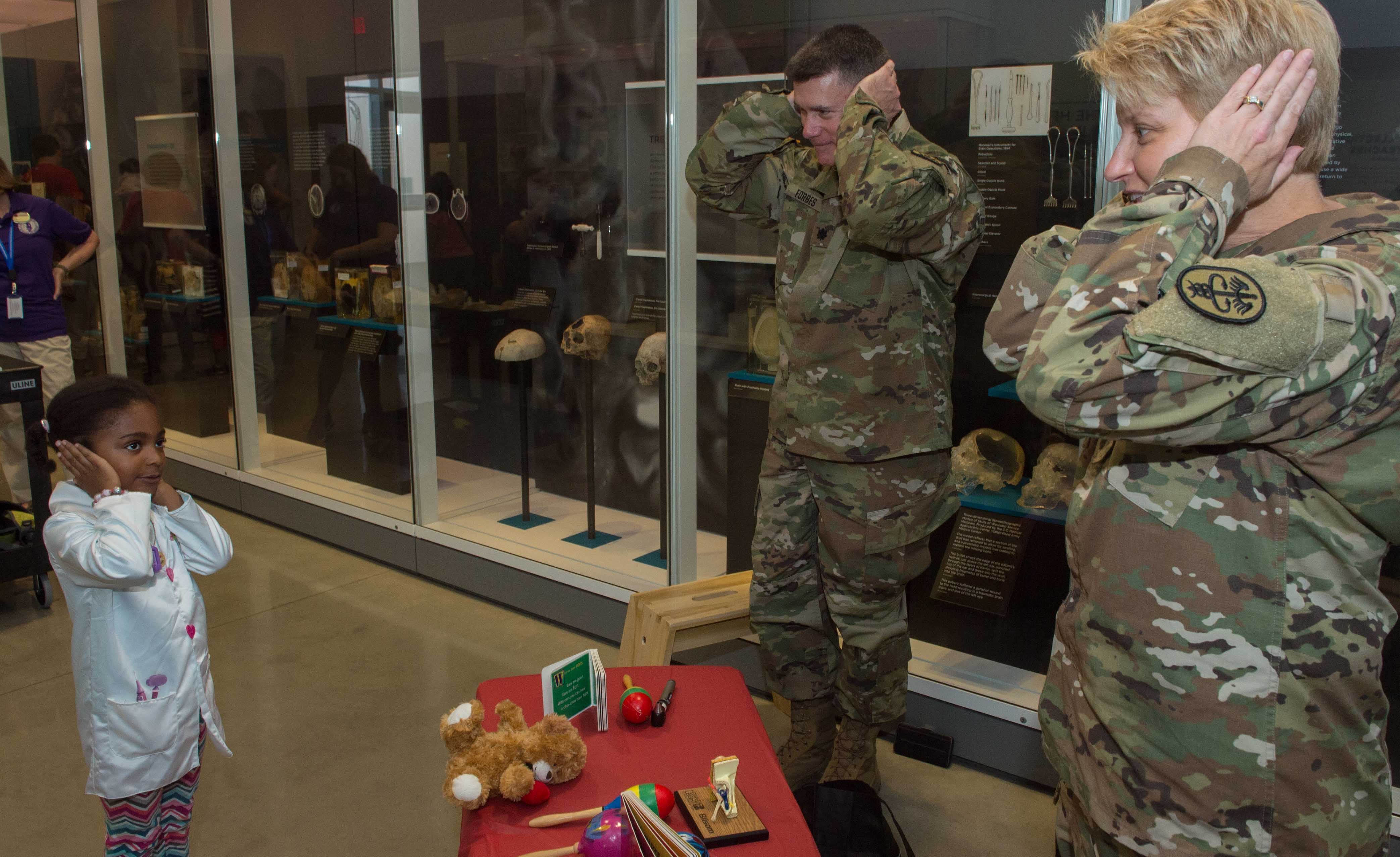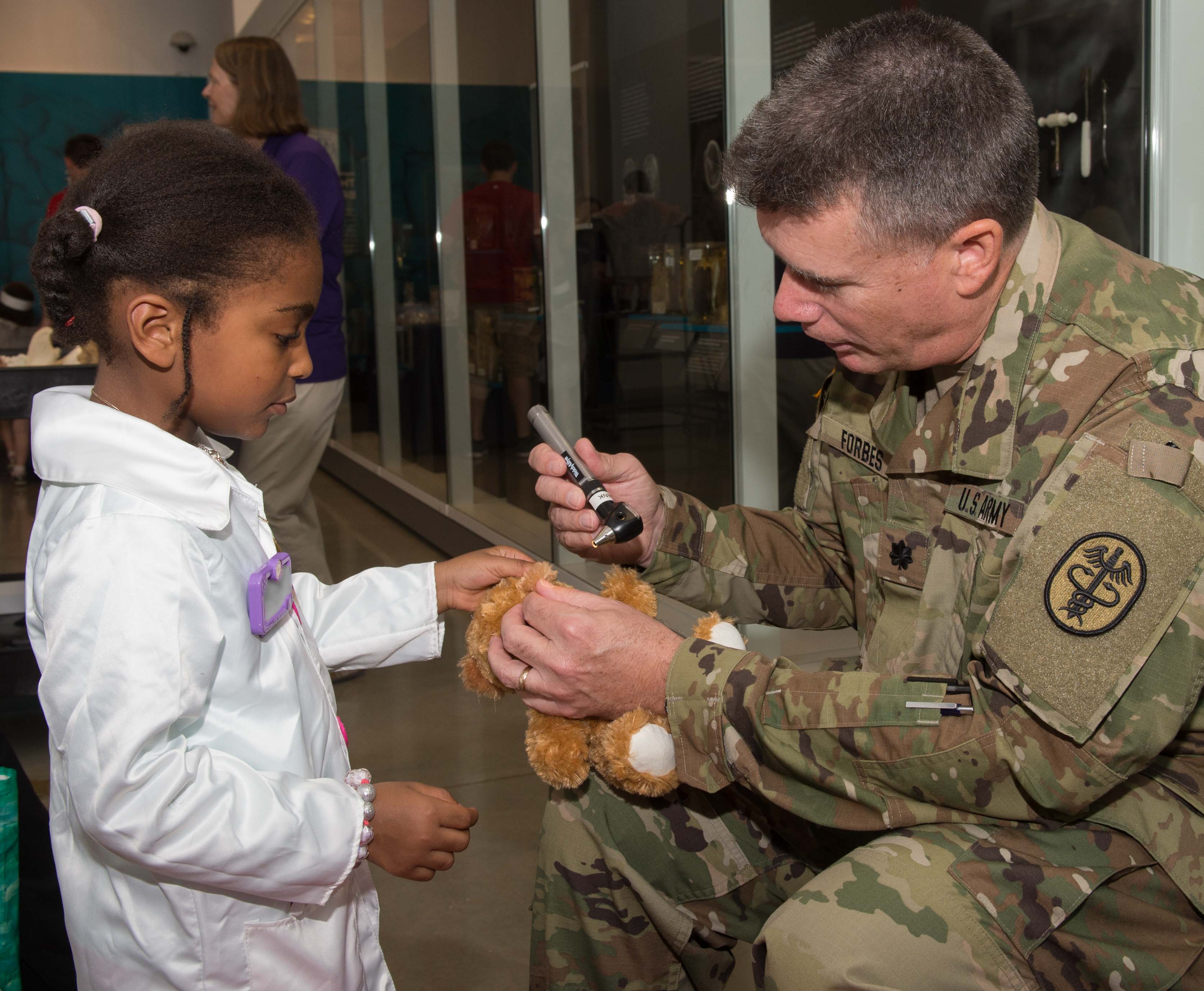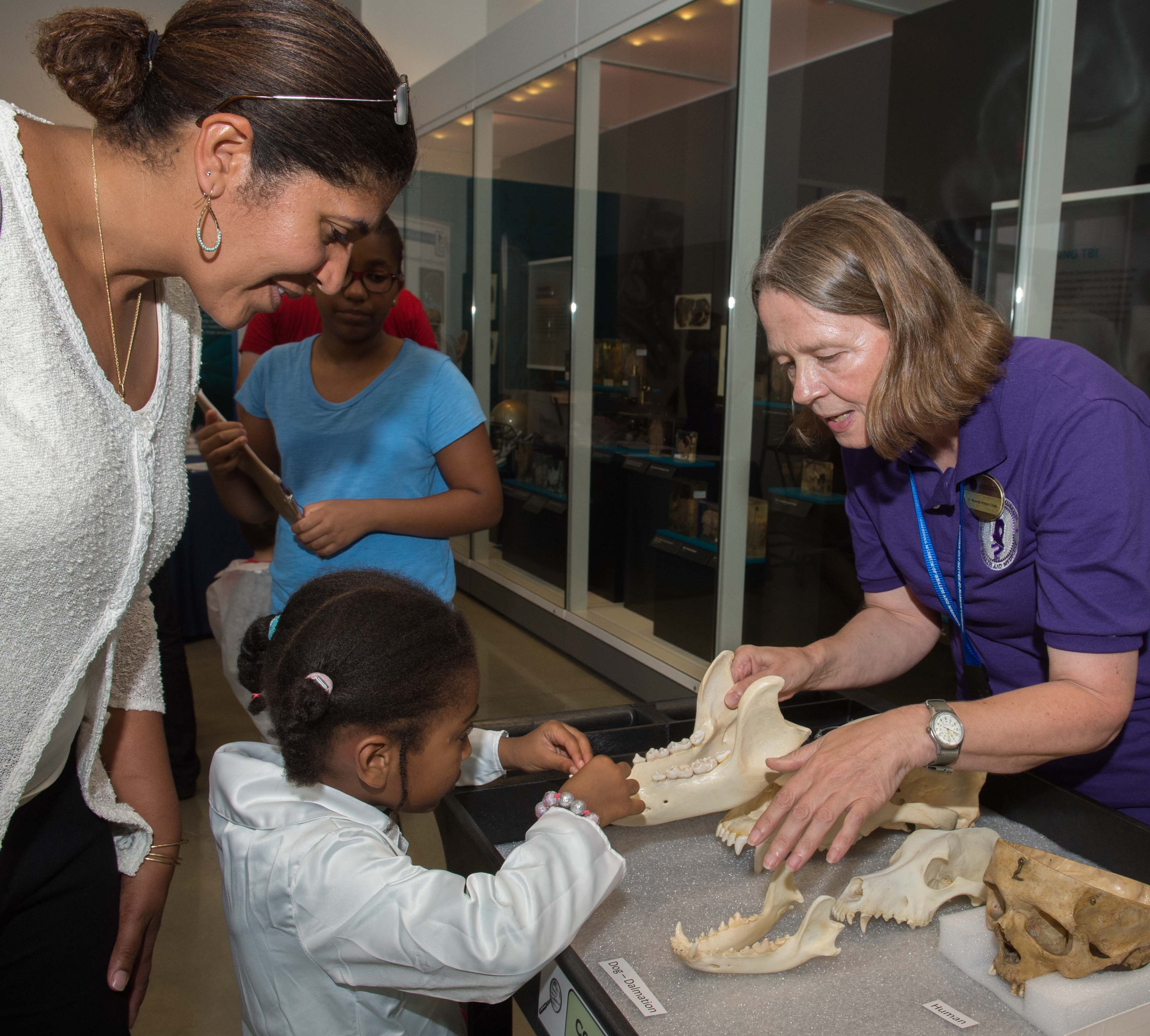When Teddy is the Patient, Learning about Health is Fun for Young Medical Museum Visitors
By Lauren Bigge
NMHM Public Affairs Coordinator
Children had fun being "doctors" and "nurses" to their stuffed animal patients and learning age-appropriate health information at the National Museum of Health and Medicine's annual Teddy Bear Clinic on Sept. 16. Since 2009, this public program at NMHM has provided an enjoyable educational opportunity for children to learn about the body, physical fitness, and healthy habits, and also learn about military medicine and military medical careers.
Attendees enjoyed hands-on activities at stations both inside and outside of the museum. They learned about vital signs, hearing, nutrition, dental health, exercise, brain safety, expressing emotions, and immunizations at different stations. Volunteers working the stations came from the Howard University Department of Physical Therapy, Defense and Veterans Brain Injury Center (DVBIC), Walter Reed National Military Medical Center’s audiology clinic, the Human Performance Resource Center (HPRC), and the Air Force’s 11th Medical Squadron, stationed at Joint Base Anacostia-Bolling.
The young visitors made doctors bags, nurses' hats, and head mirrors at the crafts tent, with the help of volunteers from the Howard University Pediatric Interest Association (HUPIA). "These are smart kids; they can actually say the names of the tools, which can be tricky," observed Maya Spencer of HUPIA, as she helped the children make their bags.
Janet Grund, health promotion coordinator and master resiliency trainer for the 11th Medical Squadron, provided a healthy food demonstration plate with food item models. "The children are doing very well at choosing healthy foods," she said. "We're introducing them to "My Plate" [which on this table is a visual cue to children that every food group has a place on the plate]. They're also getting their height and weight [measured] today."
Nearby at the immunization tent, children administered shots to their stuffed animals and heard from HUPIA volunteers that getting a shot is just a moment of pain, which keeps them from getting sick. Ellen Peltz of Silver Spring accompanied sons Theo, 6, Henry, 4, and daughter Eliza, 2, to each station. "I do think this helps them understand that going to the doctor is about more than just shots, and that's a good thing because the shots can be overwhelming to kids," she said.
Exercise station volunteer Justina Girgis, Howard University physical therapy student, said the children learned from participating in demonstrations how much activity is healthy, and that small efforts can be beneficial to their bones and muscles. "They're having so much fun," she said. "They're seeing how they can implement this in their everyday activities." Next to her, Natasha Kumar gave out nutritious snack bars and stressed the importance of fluid intake before, during and after exercise.
At the dental tent, two volunteers asked how often they brush their teeth, and then guided the children both in using circular motions on an oversized teeth model and in using yarn for a flossing demonstration. "Make sure you get all the sugar out!" said student Deborah Jack of Howard University. Erik Bertin of Bethesda was glad to see his children, Selena, 6, and Kiran, 5, learning from the volunteers. "The grad students were very engaged," he said. "They showed personal interest. Their talks with the kids are age-appropriate."
Inside the museum, the children colored teddy bear worksheets decorated with feeling words as they talked to volunteers who showed them playing cards illustrated with bears. Their intent was to help the youngsters with social and emotional development. "We've been working with them to identify some feelings," said Lauren Messina, family and relationships senior scientist for the Human Performance Resource Center (HPRC), the educational arm of the Consortium for Health and Military Performance at the Uniformed Services University of the Health Sciences. "We are also talking to them about how to be a good friend."
The children enjoyed shaking maracas as they learned about protecting themselves against noise-induced hearing loss from LTC Amy Blank and LTC (Dr.) Scott Forbes, Au.D, both of the U.S. Army, representing the Walter Reed National Military Medical Center's audiology clinic. Dr. Forbes explained that the goal was for the children to learn they can do some simple things to prevent damage to their ears. "We teach them three simple strategies, as a part of a national campaign [used by hearing conservation organizations]. We teach them to turn it down, cover their ears, and move away," he said.
Teaching brain protection was the focus just steps away, at the DVBIC station. Kenna Byrd, regional education coordinator for DVBIC, asked the youngsters to participate in an "Egg Drop" exercise, which involves dropping an egg from the top of a short ladder. "The children are quite bright; they know a bit about the brain," she said. "It's exciting for them to see the difference between a human brain and an egg, and the importance of a helmet. [They see] the egg is protected by the bubble wrapper, simulating a helmet, and then without a helmet in the Ziploc bag. I think they’re getting a little more real world, hands-on experience about brain safety."
"NMHM's Teddy Bear Clinic provides an opportunity for our younger audiences and their families to interact with medical professionals from the DoD community, as well as Howard University, in a friendly, non-threatening environment," said Andrea Schierkolk, NMHM's public programs manager. "There are so many benefits to all involved. The presenters, many of whom are currently pursuing degrees in the health sciences, gain valuable experience in interacting with young children. The children and their families learn about good health practices in a fun, interactive manner, which may help alleviate fear and anxiety about future visits to the doctor or dentist, and they are able to develop role models and perhaps build interest in pursuing careers in the health sciences themselves."
NMHM's public programs connect the mission of the Department of Defense museum with the public. NMHM was founded as the Army Medical Museum in 1862 and moved to its new location in Silver Spring, MD in 2012. Information on upcoming events can be found at www.medicalmuseum.mil.
Click any photo to view larger version








